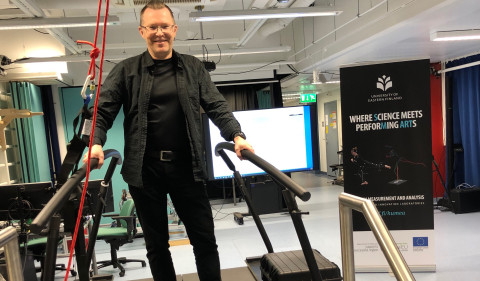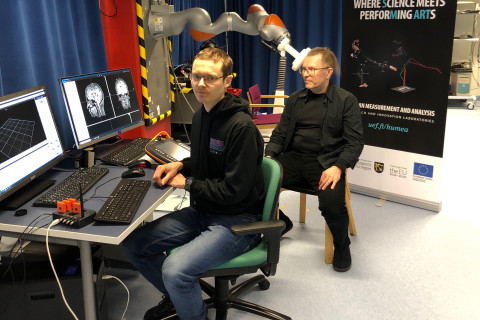The HUMEA Laboratory operates at the Department of Technical Physics, University of Eastern Finland in Kuopio and is run by the Biosignal Analysis and Medical Imaging Group (BSAMIG). The HUMEA Laboratory is an R&D environment for motion and biosignal analysis. Many research-driven corporate spin-offs have emerged from the laboratory, including Adamant Health , Heart2Save and Kubios.
The HUMEA Laboratory is a flexible R&D environment that comprises a laboratory facility and measurement equipment that can be operated independently of place. Key parts include the motion lab and robot-assisted rehabilitation development environment used for e.g. neurorehabilitation and nTMS navigation applications, a driving simulator environment and a physiology lab. Over the years, the HUMEA Laboratory’s research projects have led to forming extensive networks, thanks to the competencies in the research groups as well as cooperation with primary health care and specialised medical care.
“The focus of the HUMEA Laboratory activities is on research cooperation carried out with companies and academia and on projects that aim at the commercial applications of research”, says Professor Pasi Karjalainen, the head of the laboratory.
The HUMEA Laboratory equipment includes an instrumented treadmill with force sensors, a human 3D motion capture system, wireless EMG equipment, force plates and wearable acceleration and orientation sensors. The laboratory also utilises a variety of field-qualified measurement devices and methods. Wearable sensors have been used to develop methods for modelling the motion of the musculoskeletal system in real-time for the purposes of research in sports and work ergonomics, among other applications. Robotics, motion capture and real-time modelling of the musculoskeletal system have been combined to develop concepts for a range of applications for the rehabilitation of upper limb function in cerebrovascular disorder patients. The laboratory serves the needs of research and rehabilitation in both neurology and orthopaedics and in psychiatric therapy.
“The HUMEA Laboratory enables carrying out various studies and tests related to human motion and performance, primarily in the fields of medical research and rehabilitation but also in sports. The laboratory’s motion analysis method has been used to create 3D animations for a digital dance artwork showcasing research participants’ dance movements in a study examining the therapeutic impacts of dance on the treatment of MS and mild or moderately severe depression in collaboration with researchers in social sciences”, explains Paavo Vartiainen, a researcher in charge of the operative activities of the HUMEA Laboratory.
“For me, the best thing is that I get to meet people that we work with and can see the impacts of therapy in practice. Our aim is to also integrate the HUMEA Laboratory into the primary services of the wellbeing services county”, says Karjalainen.
Thanks to its competence in performing measurements, the HUMEA Laboratory brings together various members of the Kuopio Health ecosystem to discuss their research ideas.
“It goes without saying that the physiotherapy professionals at Savonia University of Applied Sciences are excellent partners in areas such as neurorehabilitation”, Karjalainen points out. “We also have access to the wide, international mentoring network of SPARK Finland, which supports us in our efforts to create commercial applications.”

Research impacts through projects
The HUMEA Laboratory is an active participant in projects and is actively involved in many projects that receive regional, national and international funding. The laboratory also engages in close collaboration with clinical and industrial partners.
“We’re currently involved in Co-Research, Co-Innovation and Research to Business (R2B) projects funded by Business Finland. There’s also one project funded by the Academy of Finland and one ERDF and ESF project. We're also currently making preparations for one EU Horizon project, our next R2B project and one spearhead project with Business Finland”, says Karjalainen.
For example, the new Game Over? – Continue ESF project launched in January 2023 investigates the potential of digital group gaming activities to improve the future prospects, welfare and life management of young people at risk of marginalisation from the local North Savo region.
Part of the origin story of corporate spin-offs
The R&D activities of the HUMEA Laboratory have resulted in many spin-offs and technological innovations. The arrhythmia detection algorithms of Heart2Save Oy and the HRV (Heart Rate Variability) software of Kubios Oy are largely based on the extensive work of the BSAMIG research group led by Karjalainen and docent Mika Tarvainen. The technology of Adamant Health Oy, based on precise analysis of movement disorders, relies on long-term research cooperation with clinical organisations carried out at the University of Eastern Finland and the HUMEA Laboratory.
“The commercial application of technological innovations in healthcare requires long-term research cooperation and clinical validation, an infrastructure that enables all this and an operating culture that promotes commercialisation. It’s crucial to understand the regulations related to medical devices and take these into consideration as early as possible to make the commercialisation of a research innovation possible. HUMEA has served as Adamant Health’s pillar, partner and operating environment that has enabled us to evolve relatively quickly into a growing health tech company aiming at the international market”, says Saara Rissanen, CTO and one of the founders at Adamant Health.
If you are interested in the operations of the HUMEA Laboratory or would like to collaborate with the laboratory on a research project, please contact Pasi Karjalainen or Paavo Vartiainen.
“We’re happy to participate in solving our partners’ challenging and complex research questions”, Karjalainen concludes.
Inquiries:
Pasi A. Karjalainen, Professor, Department of Technical Physics: pasi.karjalainen(at)uef.fi, +358 40 5504347
Paavo Vartiainen, Postdoctoral researcher, Department of Technical Physics: paavo.vartiainen(at)uef.fi
Kimmo Solehmainen, Development Manager, Kuopio Health Co-op.: kimmo.solehmainen(at)kuopiohealth.fi
Anna Karjalainen, Regional Manager, Kuopio Brain & Mind: anna.karjalainen(at)uef.fi
HUMEA Laboratory is a centre of measurement and analysis expertise that operates at the Department of Technical Physics, University of Eastern Finland The story is part of “R&D actors in spotlight” article series published by Kuopio Health and Kuopio Brain & Mind and it was published in cooperation on 22.3.2023.



